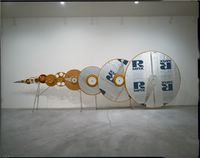Wednesday, April 06, 2005
Style Beyond Fashion
A couple things I’ve seen recently have caused me to think about time, the duration of artistic styles, and the whims of fashion.
 Tim Hawkinson has included Spin Sink in his current Whitney retrospective. These twenty-four interlocking gears, the larger of which use wide-wale corduroy for teeth, serve as a giant clock of sorts. The first miniscule gear spins at 1400 revolutions per minute. With each successively larger gear in the chain, the number of revolutions per time cycle decreases rapidly, until the final gear rotates once every century.
Tim Hawkinson has included Spin Sink in his current Whitney retrospective. These twenty-four interlocking gears, the larger of which use wide-wale corduroy for teeth, serve as a giant clock of sorts. The first miniscule gear spins at 1400 revolutions per minute. With each successively larger gear in the chain, the number of revolutions per time cycle decreases rapidly, until the final gear rotates once every century.
(Hawkinson trivia: If you Google around to find out about this piece you’ll see other mentions of the final gear rotating once every 83 years. After the work’s original showing, Hawkinson slowed down the first gear from 1600 RPM to make the last one mark out an even century.)
Watching the piece run forces viewers to contemplate their embeddedness in time. It’s impossible to see the motion of the first couple gears because they move too quickly for the eye to register. It’s also impossible, while viewing the piece, to see movement in the last 17 or 18, as their rotational cycles are measured in days, months, and years.
With this piece Hawkinson has given us a clock that marks off a century. In the period it takes the largest gear to complete one revolution, all of the work’s viewers will pass away.
Of course, the piece will never actually measure a century as it is often unplugged, moved to a new location for display, reset, then plugged back in. The work is conceptual in that way. It’s not about measuring an actual century as much as it is about the idea of measuring a century.
I thought of Spin Sink recently while I was walking through Antonio Gaudí’s Sagrada Familia in Barcelona.
Begun in 1882, construction of the cathedral continues today, with completion of the nave scheduled for roughly 2035. The building is being completed on a medieval time scale, with a groundbreaking-to-dedication project schedule that stretches over six generations. It’s possible for craftsmen on the project to spend their whole careers involved with it, and still never see the building near completion.
 Society no longer works on the time scale of centuries. In today’s corporate world a five-year time horizon is considered long-term. Hawkinson’s work calls our attention to the fact that time exists in larger increments than we plan for or observe in our everyday existence. Gaudí’s work, still moving toward completion 120 years after it was begun, reminds us of an era when taking the long view was admired.
Society no longer works on the time scale of centuries. In today’s corporate world a five-year time horizon is considered long-term. Hawkinson’s work calls our attention to the fact that time exists in larger increments than we plan for or observe in our everyday existence. Gaudí’s work, still moving toward completion 120 years after it was begun, reminds us of an era when taking the long view was admired.
In the twentieth century, and now in the twenty-first, a work like Sagrada Familia being completed over a century gets locked into a style that will be anachronistic by the time it is completed. Gaudí’s cathedral has one entrance that drips with Spanish, neo-baroque ornamentation and another that is a case study in spare, angular (but still decorative) modernism. The cathedral embraces two artistic styles that, different as they are, will both be signs of past eras when the building eventually reaches completion.
By expending tremendous amounts of effort to finish a work in a style that has moved out of fashion already, the builders of the cathedral make us take the long view, make us want to sit with Hawkinson’s Spin Sink for a little longer than we ordinarily would to see if we can spot one of the larger gears moving, to think about what will endure and what will blow away when the winds of fashion change direction next.
 Tim Hawkinson has included Spin Sink in his current Whitney retrospective. These twenty-four interlocking gears, the larger of which use wide-wale corduroy for teeth, serve as a giant clock of sorts. The first miniscule gear spins at 1400 revolutions per minute. With each successively larger gear in the chain, the number of revolutions per time cycle decreases rapidly, until the final gear rotates once every century.
Tim Hawkinson has included Spin Sink in his current Whitney retrospective. These twenty-four interlocking gears, the larger of which use wide-wale corduroy for teeth, serve as a giant clock of sorts. The first miniscule gear spins at 1400 revolutions per minute. With each successively larger gear in the chain, the number of revolutions per time cycle decreases rapidly, until the final gear rotates once every century.(Hawkinson trivia: If you Google around to find out about this piece you’ll see other mentions of the final gear rotating once every 83 years. After the work’s original showing, Hawkinson slowed down the first gear from 1600 RPM to make the last one mark out an even century.)
Watching the piece run forces viewers to contemplate their embeddedness in time. It’s impossible to see the motion of the first couple gears because they move too quickly for the eye to register. It’s also impossible, while viewing the piece, to see movement in the last 17 or 18, as their rotational cycles are measured in days, months, and years.
With this piece Hawkinson has given us a clock that marks off a century. In the period it takes the largest gear to complete one revolution, all of the work’s viewers will pass away.
Of course, the piece will never actually measure a century as it is often unplugged, moved to a new location for display, reset, then plugged back in. The work is conceptual in that way. It’s not about measuring an actual century as much as it is about the idea of measuring a century.
I thought of Spin Sink recently while I was walking through Antonio Gaudí’s Sagrada Familia in Barcelona.
Begun in 1882, construction of the cathedral continues today, with completion of the nave scheduled for roughly 2035. The building is being completed on a medieval time scale, with a groundbreaking-to-dedication project schedule that stretches over six generations. It’s possible for craftsmen on the project to spend their whole careers involved with it, and still never see the building near completion.
 Society no longer works on the time scale of centuries. In today’s corporate world a five-year time horizon is considered long-term. Hawkinson’s work calls our attention to the fact that time exists in larger increments than we plan for or observe in our everyday existence. Gaudí’s work, still moving toward completion 120 years after it was begun, reminds us of an era when taking the long view was admired.
Society no longer works on the time scale of centuries. In today’s corporate world a five-year time horizon is considered long-term. Hawkinson’s work calls our attention to the fact that time exists in larger increments than we plan for or observe in our everyday existence. Gaudí’s work, still moving toward completion 120 years after it was begun, reminds us of an era when taking the long view was admired.In the twentieth century, and now in the twenty-first, a work like Sagrada Familia being completed over a century gets locked into a style that will be anachronistic by the time it is completed. Gaudí’s cathedral has one entrance that drips with Spanish, neo-baroque ornamentation and another that is a case study in spare, angular (but still decorative) modernism. The cathedral embraces two artistic styles that, different as they are, will both be signs of past eras when the building eventually reaches completion.
By expending tremendous amounts of effort to finish a work in a style that has moved out of fashion already, the builders of the cathedral make us take the long view, make us want to sit with Hawkinson’s Spin Sink for a little longer than we ordinarily would to see if we can spot one of the larger gears moving, to think about what will endure and what will blow away when the winds of fashion change direction next.